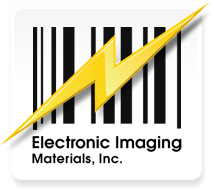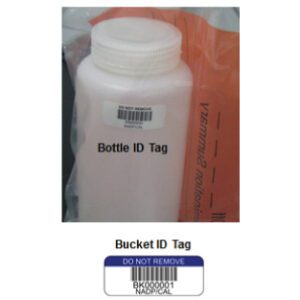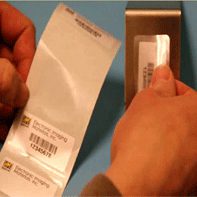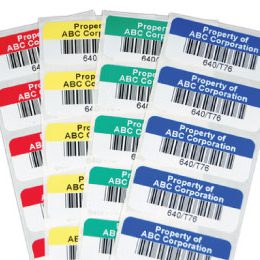Microscope slides might be small, but the stakes around labeling them are anything but. In research, clinical, and diagnostic labs, every slide carries critical data. And when labels fail? So does the workflow. Whether you’re new to lab operations or looking to improve your processes, understanding how microscope slide labels work and how to apply them properly can make all the difference in avoiding errors, delays, or sample loss.

What Are Microscope Slide Labels?
Microscope slide labels are durable, chemically resistant tags designed to adhere to glass surfaces and carry essential data like barcodes, patient IDs, or sample codes. Unlike standard paper stickers, these labels are built to survive extreme lab conditions, including high heat, solvents like xylene and alcohol, and cold storage.
Components of a High-Quality Slide Label
- Facestock: Usually made of polyester or another synthetic material that resists shrinking, tearing, or warping.
- Adhesive: Specially formulated for glass adhesion and to remain tacky under chemical and thermal stress.
- Print Compatibility: Typically works with thermal transfer printers using xylene-resistant resin ribbons for smudge-free, long-lasting print.
The right materials and adhesives make all the difference. If your label peels, fades, or smudges (when handled correctly), it’s likely because one of these components wasn’t up to the task.
Why Slide Labels Matter in Lab Settings
Microscope slides are often the foundation of critical diagnoses and research. Poor labeling can lead to delays, misidentification, and even compromised patient safety.
Supporting Compliance and Clinical Labeling Standards
In clinical and pathology labs, regulatory standards require every specimen to be traceable from collection to diagnosis. If a label fails to adhere or becomes unreadable, it could mean re-running tests, delaying results, or risking HIPAA violations. Effective clinical labeling hinges on reliable microscope slide labels that stay readable and securely in place.
Enabling Automation
Many modern labs use automation systems to scan and sort lab slides. These systems require consistent label placement, scannable barcodes, and materials that won’t jam machines or distort under temperature changes. A misaligned or damaged label can halt an entire process line.
Preserving Sample Integrity
The label is the link between your physical slide and your lab information system. Without it, a sample becomes anonymous. Durable microscope slide labels ensure that a slide’s identity is never compromised, no matter how many stains, washes, or storage transitions it undergoes.
Best Practices for Applying Labels to Lab Slides
Applying a microscope slide label might seem simple, but there’s a right way to do it. A few wrong moves can result in misreads, peeling, or smudging. Getting these steps right up front prevents costly rework and maintains sample traceability.
Clean the Surface Thoroughly
Microscope slides should be completely dry, free of dust, oils, glove powder, or condensation. Contamination on the glass weakens the adhesive bond and invites future peeling or curling.
Use Consistent Label Placement
For automation systems and scanning workflows to run smoothly, every label needs to be placed in a uniform location on the slide. Keep labels upright and positioned consistently so barcodes are scannable without manual adjustment.
Apply Firm, Even Pressure
Don’t just stick and go. After placing the label, use a firm, even pressure across the surface to activate the adhesive and ensure full contact with the slide.
Store Slides in a Controlled Environment
Humidity, temperature changes, and vibration during storage can all affect label performance. Ensure your storage area is stable and doesn’t introduce risks that could lift or damage the label.
Can You Print Microscope Slide Labels In-House?
Yes, you can—if you’re equipped properly. Many labs choose to print their slide labels in-house using thermal transfer printers. This approach offers greater control over workflows and allows for quick adjustments to labeling needs as they arise.
What You’ll Need
- Thermal Transfer Printer: This type of printer delivers the resolution needed for crisp, scannable barcodes.
- Xylene-Resistant Ribbon: Essential for maintaining print integrity when exposed to staining chemicals and solvents.
- Approved Label Stock: Specially formulated materials designed to bond securely with glass and withstand chemical, thermal, and moisture challenges.
Setting up in-house labeling isn’t just about buying a printer. It’s about pairing the right ribbon with the right label stock and making sure everything works together seamlessly.
Which Labs Use Microscope Slide Labels?
Slide labels are essential anywhere microscopy plays a central role. These environments demand precision and resilience in labeling, regardless of lab size or specialty.
Common Environments Include:
- Clinical Labs: Focused on patient diagnostics and regulated under CLIA or CAP standards, where accuracy and traceability are non-negotiable.
- Research Labs: Supporting studies in biology, pharmacology, or genetics, where slide labeling is crucial for sample management and repeatability.
- Pathology Labs: Processing biopsies, autopsies, and medical samples for diagnosis, requiring labels that survive staining and archiving.
- Academic Labs: Teaching environments where students must learn best practices in specimen tracking and labeling consistency.
If the process includes microscopy, it likely includes slide labeling. It also likely demands labels that hold up to the lab’s unique workflow and compliance requirements.
Whether you print in-house or outsource labels, durability matters. If your lab is experiencing peeling labels, smudged barcodes, or relabeling headaches, it might be time to upgrade. Electronic Imaging Materials (EIM) delivers expert guidance, free label samples, and helps select a thermal printer setup tailored to your lab.
How Labels Are Used Throughout Slide Lifecycles
Microscope slides endure a rigorous journey from preparation to storage, and their labels must keep up every step of the way. Each stage presents different environmental stressors that can compromise unfit labels, making material quality and application precision vital to long-term success.
During Sample Staining
During staining protocols, slides are routinely submerged in harsh solvents such as xylene or alcohol. These chemicals can quickly degrade inferior labels, leading to fading or complete detachment. A proper slide label must withstand repeated chemical exposures while maintaining clarity and adhesion.
While Under Analysis
Slides are frequently handled and scanned, sometimes multiple times. Technicians and automated systems alike depend on crisp, readable barcodes and labels that remain in place. Smudging, fading, or curling can all slow down analysis and risk inaccurate or incomplete data capture.
Through Storage and Archiving
Long-term storage can include anything from ambient room conditions to deep freezing. Labels must all resist cracking, peeling, or fading over time. Cold environments, in particular, can cause adhesives to become brittle unless the label is designed to handle temperature extremes.
In Slide Mailers and Containers
Labeling extends beyond the slide itself. Mailers, organization trays, and specimen containers also need labeling that withstands solvents, handling, and temperature changes. Ensuring every label in the chain meets durability requirements reduces the risk of misidentification or sample loss during transit and archiving.
Slide Label Selection Tips
Choosing the right microscope slide labels is about knowing how each component works with your lab’s environment, processes, and automation systems. A label that performs beautifully in one lab might fail in another. Here’s how to ensure your selection process sets you up for success.
Choose the Right Adhesive
Glass isn’t easy to stick to. Your label adhesive must bond well to a smooth, nonporous surface and resist lifting during temperature swings or solvent contact. A pressure-sensitive acrylic adhesive may perform well at room temperature but fail in a solvent-heavy workflow. Be sure to match your adhesive choice to the full lifecycle of your slide, from prep to storage.
Pick a Chemically Resistant Material
Microscope slides are exposed to aggressive chemicals like xylene and alcohol, especially during staining processes. If your slides face repeated chemical baths or high-temperature protocols, use a polyester or polyimide facestock built for rugged environments. These materials offer long-term readability and prevent breakdown, even after multiple exposures. Choosing chemically resistant materials is crucial to prevent label degradation that could lead to relabeling or, worse, specimen misidentification.
Consider Pre-Printed vs. Self-Laminating
- Pre-printed labels arrive ready to go. This minimizes in-lab printing errors and speeds up your process. They’re ideal for high-throughput labs or workflows requiring consistent formatting.
- Self-laminating labels allow you to print barcodes or text in-house and seal them with a protective layer to prevent smudging or fading after printing. This is especially helpful when labels will be subjected to repeated handling, staining, or long-term storage.
EIM offers both options, giving labs the flexibility to choose based on labeling volume, available staffing, and existing equipment. Whether you want plug-and-play simplicity or on-demand customization, we’ll help you find a label that integrates seamlessly into your workflow.
Find Labels That Stick With You
Electronic Imaging Materials knows slide labels aren’t one-size-fits-all. Each lab has different workflows, chemical exposures, and compliance pressures. That’s why we build labeling solutions that are engineered to endure.
With EIM, you get:
- Labels that resist xylene, freezing, and abrasion
- Experts who can help assess your workflow and recommend improvements
- Thermal printing and ribbon options tailored to your setup
- Fast access to samples so you can test before you commit
Don’t let a small label create big problems. Contact EIM today to start building a slide labeling strategy that works as hard as your team does.





